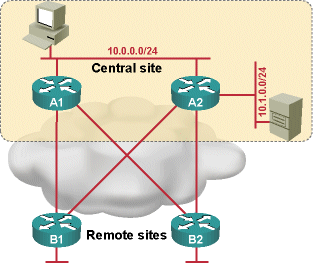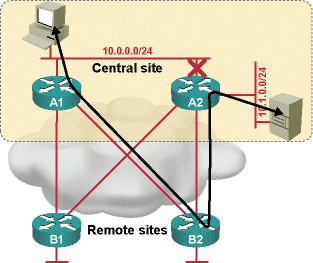Dual-Homed Remote Sites
Articles » Scaling EIGRP Networks with Stub Routers » Dual-Homed Remote Sites
In most mission-critical networks, the remote sites have at least two upstream links to two core routers (see the next diagram). In these designs, the amount of DUAL traffic generated by an outage is significantly higher than in the previous scenario, as both central routers start querying the remote offices.

Dual-homed hub-and-spoke WAN network
Furthermore, if the core routers lose their direct connectivity (for example, the LAN interface of one of them fails), the transit traffic might start flowing across remote sites, congesting their slow-speed links:

Link failure turns spoke sites into transit sites
Both undesired effects are solved very effectively by the EIGRP stub routers. The stub routers are not queried in the DUAL process, thus the WAN link congestion is avoided. Furthermore, as these routers never propagate EIGRP routes to other EIGRP neighbors, they cannot become transit routers.
For example, the next printout displays the EIGRP topology table on router A1 when the connectivity between A1 and A2 was lost and the remote office routers were not configured as stub routers. The routes beyond A2 are reachable through all remote office routers (B1 and B2).
a1#show ip eigrp topology 10.1.0.0 255.255.255.0
IP-EIGRP (AS 1): Topology entry for 10.1.0.0 255.255.255.0
State is Passive, Query origin flag is 1, 2 Successor(s), FD is 2684416
Routing Descriptor Blocks:
172.16.1.33 (Serial0/0/0.401), from 172.16.1.33, Send flag is 0x0
Composite metric is (2684416/2172416), Route is Internal
Vector metric:
Minimum bandwidth is 1544 Kbit
Total delay is 40100 microseconds
Reliability is 255/255
Load is 1/255
Minimum MTU is 1500
Hop count is 2
172.16.1.2 (Serial0/0/0.100), from 172.16.1.2, Send flag is 0x0
Composite metric is (2684416/2172416), Route is Internal
Vector metric:
Minimum bandwidth is 1544 Kbit
Total delay is 40100 microseconds
Reliability is 255/255
Load is 1/255
Minimum MTU is 1500
Hop count is 2
When the remote office routers are configured as stub routers, A1 loses its connectivity to 10.1.0.0/24 when its connection to A2 is lost:
%DUAL-5-NBRCHANGE: IP-EIGRP(0) 1: Neighbor 10.0.0.6 (FastEthernet0/0) is down: holding time expired
a1#show ip eigrp topology 10.1.0.0 255.255.255.0
% IP-EIGRP (AS 1): Route not in topology table
